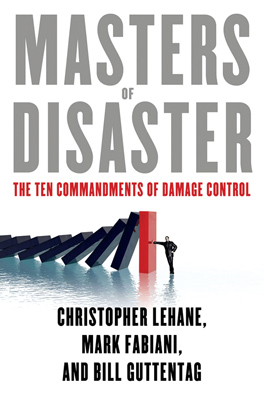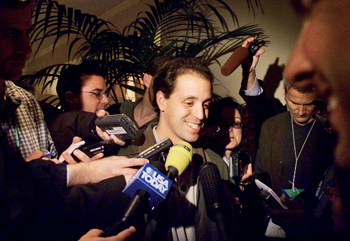Reviewed by Paul Statt ’78
[Politics] “Terrible Disaster” is the name of a game my favorite 4-year-olds play. With couch cushions, throw pillows, the dog’s bed and anything else that’s soft and safe, Claire and Abby build a fairytale castle or pirate ship on the living-room carpet.
My part is to destroy it in a shipwreck or hurricane, stranding the giggling girls in an uproarious heap on the carpet, all the while intoning seriously, “It’s a terrible disaster!” It’s all make-believe, of course. In telling the story, I’m in control, scaring the girls even as I’m assuring them that all’s well. They might call me the Master of Disaster.

The original “master of disaster” is political consultant Chris Lehane. That’s been his epithet since Newsweek stuck it on him in 1995. Lehane had captained the PR response that successfully weathered the scandals of the Clinton White House. He tells those stories and many more in his new book, Masters of Disaster: The Ten Commandments of Damage Control (Palgrave Macmillan), co-written with Mark Fabiani and Bill Guttentag, in which he also enlightens us about the techniques that inspired The New York Times to dub him the “Master of the Political Dark Arts.”
It’s not really black magic, though, just an appeal to some facts of life. Everybody loves a story, and every story needs a crisis. As Claire and Abby—and all the rubberneckers on the Jersey Turnpike—know, human curiosity about catastrophe runs deep. Everybody likes a shipwreck, although we would rather see than suffer one. Masters of Disaster is a pilot book for navigating the almost inevitable public relations kerfuffle in your future.
Ten Commandments almost seem too many. The Golden Rule of PR is that you have to tell your own story. If you don’t, somebody else will. In romance, it will be your rival; in politics, your opponent; in business, your competition. A story needs a beginning, a “turning point” and an end. Every turning point is a crisis and inspires a story. PR is storytelling, and storytelling is how public relations professionals like Lehane craft “damage control.” He helps folks whose livelihoods depend on being chattered about and paid attention—politicians, actors, sports stars—when the public gaze gets too intense. “I can do this myself,” might be your skeptical reading of Masters of Disaster, after being entertained by Lehane’s witty re-retelling of famous PR disasters. But most of us, like Claire and Abby, require a little help with our tales and welcome the calm presence of an avuncular storyteller.
On the evidence of this book, Lehane (an Amherst trustee) is the guy you want to be seated beside at dinner: a charming raconteur of ruined reputations. Sometimes the fun of the tale is that Lehane was there, as in Monica Lewinsky and Whitewater, but many a PR disaster he recounts—in politics, business or sports—is a familiar tale told well: Tiger Woods, Herman Cain, Tylenol.
Trained as a lawyer (Harvard 1994), Lehane and his coauthor Fabiani run a strategic communications firm that counsels businesses, actors, politicians and pro athletes: characters whose public images often are formed where law, money, politics and communications meet. His firm has represented clients as varied as Goldman Sachs, Lance Armstrong, the National Hockey League and Hollywood studios.
But my favorite among his stories recounts how he and his wife rescued the reputation of their pet Lola after an altercation with an overzealous canine companion at the dog park. It’s instructive to see how Lehane applies his commandments for damage control in such a homey setting, far from Washington or Hollywood. It would make a great movie.
As in the classic movies, Lehane mines nuggets of dialog to adorn his commandments. You know the lines. Sunset Boulevard: Be ready for your close-up (that is, get your facts straight). Cool Hand Luke: Do not fail to communicate. Casablanca: You may feign surprise, but never let yourself be shocked. The latter reinforces a subtler message: the story you tell has to be believable. What Lehane learned at the movies is to provide a plot, characters or a setting that the public is already familiar with.
Lehane himself is now starting a movie career of sorts. He and co-author Guttentag have written a film, Knife Fight, a satire loosely based on Lehane’s work in political imagineering. Lehane’s story comes around and makes sense somehow: He convinces politicians to think like directors, to see the campaign like a movie and create a narrative. Then Lehane’s story becomes the narrative. Who plays Lehane? Rob Lowe, of course, whose career once went like this: Brat Pack, sex tape, rehab.

Onscreen and off, professional actors understand this need to invent and reinvent our stories. Joan Crawford, whose mercurial career could serve as an object lesson in Masters of Disaster, speaks the truth in Otto Preminger’s 1947 melodrama, Daisy Kenyon: “There’s nothing like a crisis to show what’s really inside people.”
Statt is a communications consultant. His last piece for Amherst magazine was a review of the book 1493.
Photo from AFP/Getty Images